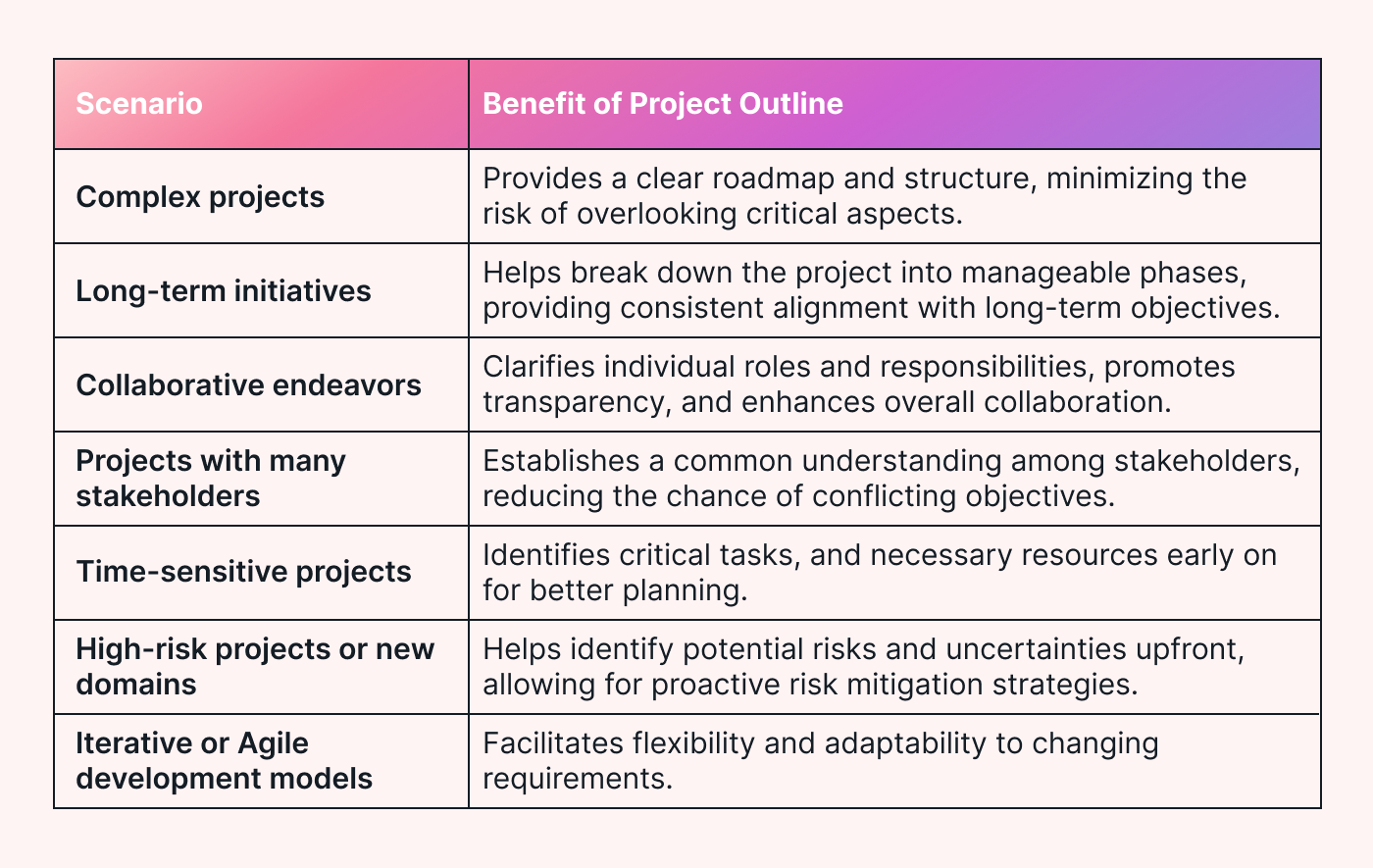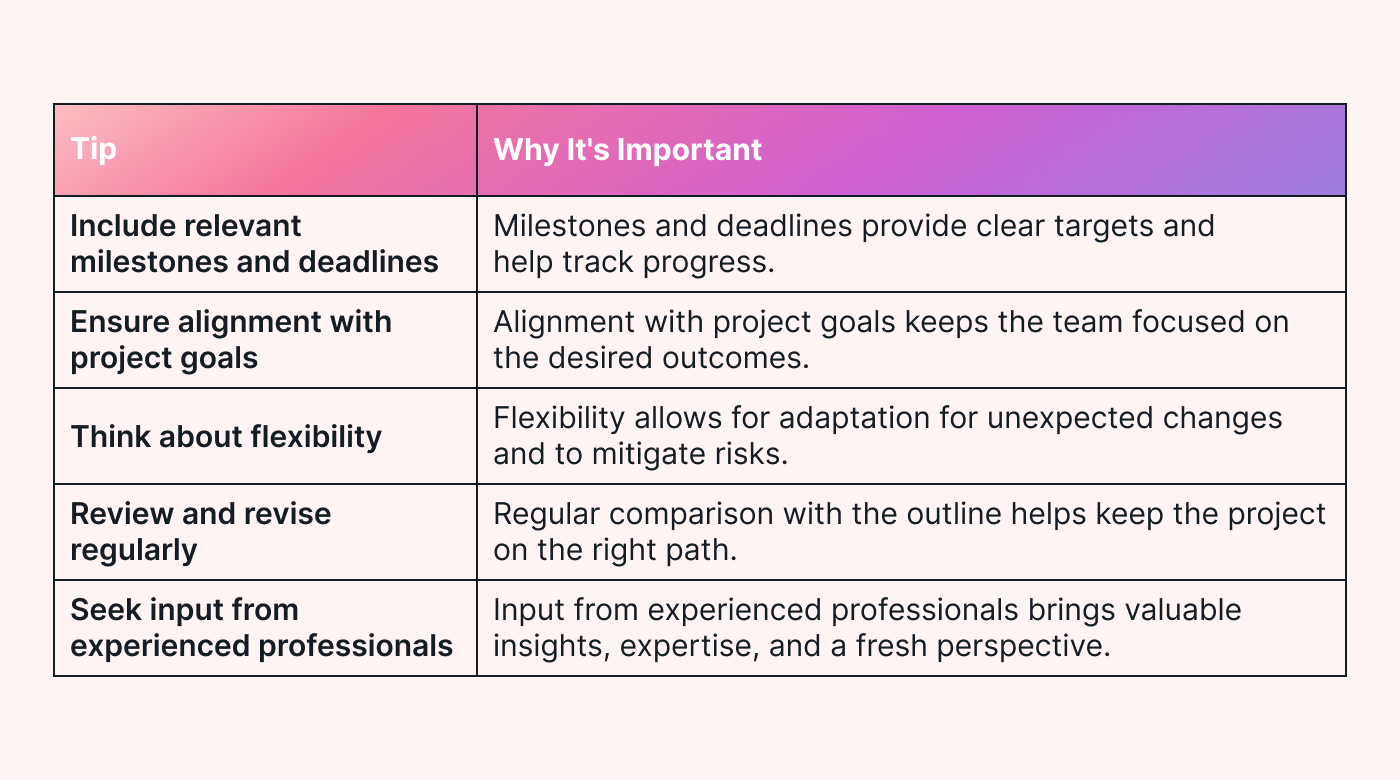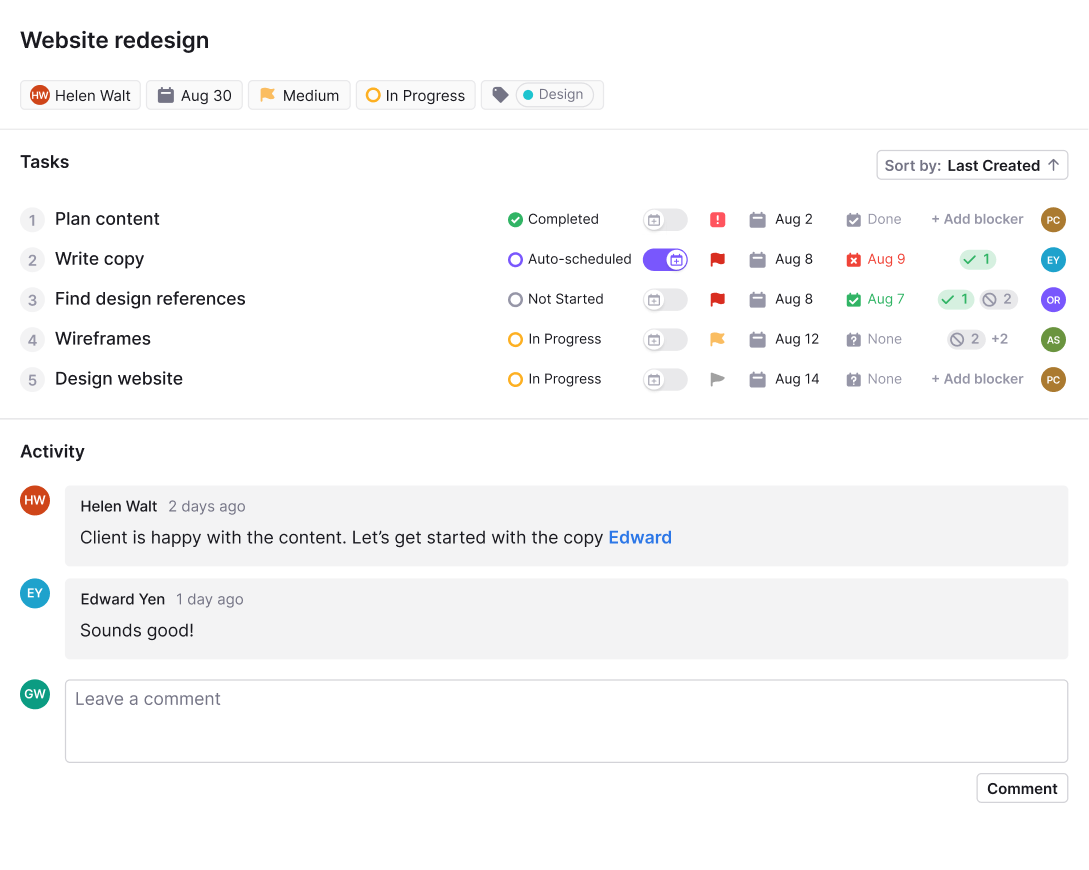Are you tired of sifting through scattered project details, lost in a maze of endless tasks?
Do you yearn for a streamlined solution to transform your chaos into clarity?
The answer? A properly planned project outline.
In project management, success lies not only in execution but in the art of planning. Research suggests that ⅔ of projects fail because they don’t integrate planning. And proper planning all starts with a good project outline.
In this guide, we'll delve into the art of creating a robust project outline that'll keep you on track, organized, and laser-focused. We'll also share actionable tips, expert insights, and a step-by-step template.
Let's dive right in.
What is a project outline?
A project outline serves as a robust document, mapping out your project's essential components and goals. It's like creating a detailed playbook for project success right from the start.
A well-defined outline clearly shows the structure of your project. With this clarity, your project's organizing and planning can happen more smoothly and more accurately.
But there are many more pros to an outline. They can help:
- Break down big tasks into manageable steps
- Allocate resources effectively
- Track progress
- Identify potential obstacles
- With creation of the project timeline & work breakdown structure (WBS)
Let's say you're running a construction company as an example. And you have a major project coming up—a commercial building construction. Using an outline, you can work out the project phases. Each phase could further be broken down into specific tasks and milestones with a WBS. The company can use the outline to plan resource usage and create a realistic timeline. They can also use it to help spot potential challenges early on and plan how to handle them.
When to do a project outline
Most methods call for creating a project outline during the initial planning phase. Doing it early on is really important if you want to make the most out of this tool. You should also keep in mind that you don't want to use too many resources or allocate too many until you have an outline ready.
 |
A project outline is particularly valuable in various scenarios, such as:
- When tackling complex projects.
- You have projects with many interdependencies.
- Even for long-term initiatives, you can define the phases, to help keep you on target throughout the extended timeline.
- Cross-functional teams thrive when they can clearly see their goals; a great outline can give them that.
While grand structures like the Empire State Building may require full-fledged project plans, a concise project outline may be all you need to steer your efforts efficiently from beginning to end for most projects.
What's included in a project outline?
A well-rounded project outline should consider all the crucial aspects of your project.
Let's dive into the key elements you'll find in a project outline:
- Title and Description: should introduce the project.
- Project Objectives: outline the specific goals and outcomes you aim to achieve. They serve as the guiding principles for decision-making and project evaluation.
- Scope of Work: defines the boundaries and deliverables of the project. Also referred to as project scope.
- Key Stakeholders and Roles: for the project. Key stakeholders are individuals or groups directly involved with or affected by the project. Roles are assigned to different stakeholders to clarify responsibilities and facilitate collaboration.
- Timeline and Milestones: provides a high-level overview of the project's schedule and major achievement targets, or milestones.
- Resources Needed: encompass the personnel, budget, equipment, and external support required for the project.
- Dependencies: highlight the relationships and interdependencies between tasks and deliverables. They help identify which activities must be completed before others can start or progress.
- Risks and Mitigation Plans: involve strategies to anticipate, manage, and mitigate identified risks.
Project outline template
Here's a basic outline you can customize to your specific project requirements.
1. Project Title: [Insert Project Title]
2. Project Description: [Provide a brief overview of the project's purpose]
3. Project Objectives:
- Objective 1: [State the first specific project objective]
- Objective 2: [State the second specific project objective]
- Objective 3: [State the third specific project objective]
- [Add more objectives as needed]
4. Scope of Work:
- In-Scope items: [List the tasks and deliverables included in the project scope]
- Out-of-Scope items: [Specify what is not included in the project scope]
5. Key Stakeholders and Roles:
- Internal Stakeholders: [Identify internal groups or departments involved and their roles]
- External Stakeholders: [Specify external individuals or organizations involved and their roles]
6. Timeline:
- Start Date: [Enter the project start date]
- End Date: [Enter the project end date]
7. Milestones:
- [Specify significant project milestones and their target completion dates]
- [Add more milestones as necessary]
8. Resources Needed:
- Personnel: [List the team members and their respective roles]
- Budget: [Specify the allocated budget for the project]
- Equipment: [Identify any specific equipment or tools required]
- External Resources: [Mention any external resources or organizations needed]
9. Dependencies:
- [Outline the dependencies between tasks or deliverables]
- [Indicate the sequence of activities and any prerequisites]
10. Risks and Mitigation Plans:
- Identified Risks: [List potential risks or challenges that may impact the project]
- Mitigation Plans: [Describe strategies to address and mitigate each identified risk]
Remember, this project outline template is meant to be flexible and adaptable. Feel free to modify sections, add details, or remove irrelevant components to fit your project's unique needs.
Create a project outline in these 2 steps
You can follow these two additional steps using the outline above as your guide. These are focused more on gathering info and writing it correctly.
 |
1. Collect the necessary info
Let’s first focus on how to gather the information you need for the outline.
Identify project goals and objectives.
To help you identify goals and objectives, you should ask yourself: What is the main purpose? What does the project hope to accomplish? This will give you a clear direction to follow.
Gather project requirements.
For requirements, think about the necessary tasks, materials, or tools. Consider what resources you’ll require to complete each requirement.
Conduct thorough research.
In terms of research, look for information, data, or insights that relate to your project. Explore search engines or top sources for industry trends, best practices, or similar projects.
Involve stakeholders.
According to research, less than half of delivered projects achieve stakeholder satisfaction. Making the role of gathering and involving them early on even more important.
To involve the stakeholders and gather their information, use workshops, surveys, or meetings. Otherwise, consider using user stories. User stories are an Agile technique used to identify stakeholder requirements by mimicking what stakeholders want.
User stories are now common in other methodologies too, to document requirements.
Review existing documentation.
Take a look at any previous documents or materials related to similar projects. This can include reports, plans, or other relevant documents. Reviewing these materials can give you ideas, lessons learned, or potential challenges to consider.
Determine project dependencies and risks.
Here you should identify the tasks or parts of your project that depend on each other. Also, think about potential risks or uncertainties that could affect your project.
Document key milestones and timelines.
Here, you break down your project into smaller steps or milestones. Work out rough target dates for each milestone to help with planning later.
Document stakeholder communication requirements.
Determine your stakeholder communication preferences and plan them out.
Organize and centralize collected information.
Keep all the information you gather in one central place. Use tools like project management software or a shared document to organize everything.
2. Write out the project outline
After gathering all the required info, you are ready to start writing your outline.
Here you have two easy options.
Option 1: Take the outline we provided earlier and fill in the details using the information you have gathered. This will give you a structure for your project outline.
Option 2: Try to do it yourself. Start by organizing your thoughts and information concisely. Structure the outline logically so that it flows smoothly from one section to another. Be clear and specific with your descriptions and objectives.
Tips to make a bullet-proof outline
In the image below, we have broken down why these tips are important before quickly reviewing how to implement them.
 |
Let’s go over applying these tips:
1. Include relevant milestones and deadlines: You can do this with a WBS or by dividing your projects into logical phases, for example:
- Data gathering,
- Planning,
- Design,
- Testing,
- Review.
2. Ensure scope alignment with project goals: Regularly check if the scope of your project aligns with the goals you’ve defined.
3. Consider flexibility: Anticipate changes and uncertainties by building flexibility into your outline. Leave room for adjustments and contingencies to adapt to unexpected circumstances.
4. Review and revise regularly: As you gather new information or encounter changes, adjust your outline accordingly to keep it up to date.
5. Seek input from experienced professionals: Ask them to help you review the quality of your outline.
Motion helps to create comprehensive project outlines
With Motion you can create comprehensive project outlines with ease. It is an AI-powered project tool that takes the stress out of project planning.
 |
You can visually map out timelines and milestones to help you create a better outline. It can also intelligently identify dependencies based on your project data.
Motion can further integrate with your tools and combine all the necessary information in one place.
And when it comes to putting a plan into action, it can organize tasks based on priorities, deadlines, and availability. It can plan your day for you and your team to make sure they stay focused and smash goals.
Sign up for your 7-day free trial.





